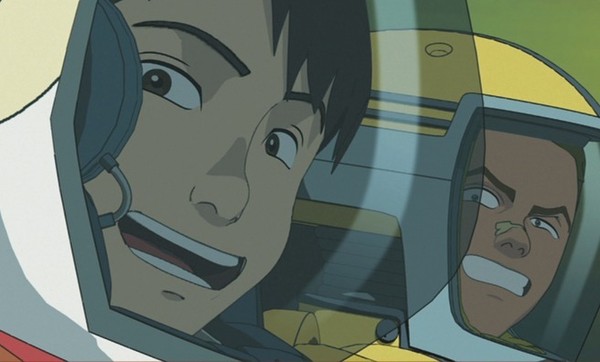When it
starts out, it appears that Freedom is going to be a by-the-numbers
mecha/racing drama, but don’t
buy into that. Over the course of its brief lifetime (7 episodes)
Freedom will go through several iterations of personality; becoming at
various times a serious space adventure, a conspiracy thriller, a zany
road trip and a light-hearted romance/comedy.
The story
begins in Eden, a city on the moon which was meant to be the staging
point for a terraforming mission to Mars. But with that mission
scrapped, and the Earth an apparent wasteland, Eden is seen as the last
bastion for humanity. Personal freedoms are few but comforts are in
abundance, and all that the government ask in return for a life of cosy
security is strict adherence to the rules.

Enter into
this setting Kazuma and Takeru, two youths who have just found a
derelict moon bike. With the help of their friend Biz they hope to
restore the machine and compete in the illicit underground racing scene.
Takeru’s
stubborn attitude soon brings him into conflict with Taira, an ace
rider, and the two face off in a spur-of-the-moment race. But when
Takeru’s
machine breaks down he is caught outside during curfew, and sentenced to
community service- a job that involves menial work on the moon’s
surface, outside the dome. It’s
during one of these monotonous shifts that he makes an incredible
discovery: A photo of a teenage girl, which appears to show Earth as a
sunbaked paradise. After that, the boys begin to suspect that the
government isn’t
telling them the whole truth, and they vow to find out more.
You can
sense many different creative influences on Freedom, all pulling the
series in different directions. But far from it being a case of that old
adage, ‘too
many cooks,’
these distinct styles compliment each other. The story itself is simple,
fickle and at times illogical, but the characters act as a glue to hold
it all together. The structure of the episodes often feels eccentric,
but the characters remain a charming constant. Each has his or her own
place in the adventure, and before long they all feel essential.
Audio/Video:
The visual
style of Freedom is very attractive, with CGI models for characters and
vehicles. The backdrops have a sketched look, and are fleshed out with
bright primary colours and pastels.
The sound
effects are spot on, with different bikes and vehicles all having their
own individual roars and whines. They haven’t
quite nailed the audio mix though, because during some of the more
dramatic scenes a rather pedestrian musical score is completely
overpowered by the sound effects.
Special Features:
-
Introduction Trailer
-
?Freedom
Digests: A short synopsis of each episode
-
Talking about Freedom, session 1: Series planner Dai Sato and
Director Shuhei Morita talk about the different creative influences
on the show
-
Another vehicle race: A slightly cool, somewhat pointless short in
which the moon racers are relocated to a modern-day Earth setting
-
Nissin
Cup Noodle TV digest: Another TV spot featuring some product
placement
-
Talking about Freedom, session 2: Sato and Morita reflect on the
long gestation period between episodes, and how it affected the
final product
Closing comments:
There are
some powerful moments of imagery in Freedom, and you feel as if they've
been included for the sake of drama more than that they further the plot
in any way. But none of that really matters, because this series is so
big on heart. Besides which, a post-apocalyptic revival of the Apollo
program is a pretty cool idea. There’s
a lot of love here.